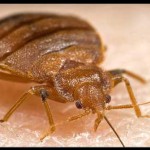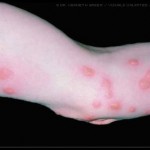Like many of you I grew up with the innocent “don’t let the bed bugs bite” mantra before being sent off to bed as a kid. Heck, we all knew there were no more likely “Bed Bugs” than monsters under the bed. Or did we?
 Bed bugs infest the United States at an alarming rate, especially in the Northeast. Some pest management firms have reported more than a 10-fold increase in bed bug treatments in recent years.
Bed bugs infest the United States at an alarming rate, especially in the Northeast. Some pest management firms have reported more than a 10-fold increase in bed bug treatments in recent years.
Why? A number of theories exist:
- the rise of international travel
- recycling of furniture
- the ban of some of the more potent insecticides such as organophosphates and carbamates
Identification of infestation can occur in several ways. Common signs include blood spotting on bedding and a characteristic sickishly sweet odor. Certainly allergic reactions to bug bites are a sign hard to ignore. Bed bugs are very good a flattening their bodies and can be very difficult to find because they can run very quickly. Pest control professionals are usually required to make positive identification and speciation. They use physical inspection which is relatively difficult compared to the use of canines. Yes canines (dogs)! These specially trained dogs are very good at identification, especially useful in larger buildings such as dormitories and hotels, since they can identify infested rooms individually to avoid overtreating the entire building for bed bugs.
 Remediation historically used a variety of insecticides but a new method is becoming increasingly popular: thermal remediation.
Remediation historically used a variety of insecticides but a new method is becoming increasingly popular: thermal remediation.
Thermal remediation consists of warming the interior of the house and/or infested furnishings and contents to approximately 135 deg F for a period of approximately five to six hours. During this heating process the interior temperatures are monitored and logged continuously to assure a thorough kill. Room heaters powered by either a remotely connected electric generator or gas-fired heaters are typically used to generate the heat in various sections of the building and supplemented with high velocity circulating fans to homogenize the temperature. The goal is for all contents that could harbor bugs and/or eggs to reach the desired temperature for the bake out period. Sometimes, especially in hotels or dormitories, the contents of the room are removed and placed in a large box truck outdoors equipped with a high-powered heating system. This is easier than “cooking” the room depending upon the number and size of the infested rooms.
This is where Thayer Corporation comes in. As experts in the field of heating, cooling and ventilation, we were consulted to offer methods of improving this heating process. We have already identified several improvements to the process and are currently working on even more comprehensive enhancements.
Thermal Remediation has several advantages over traditional methods. While use of chemicals remains the most popular method, it requires a significant quantity of insecticide and it may be necessary to perform multiple applications as well over a period of time. It isn’t unusual for applicators to dismantle furniture in order to get the chemical to all bugs and egg laying places. The chemical approach requires the applicators be licensed and well trained.
Vacuuming and steaming is yet another method of remediation. The affected areas are both steamed to kill the bugs and eggs and removed with HEPA vacuums. This method isn’t as effective as other methods since the critters are very good at hiding in the smallest cracks and crevices. The other concern with the method is the potential damage may have to furnishings and the wetting that can lead to mold and/or microbial growth.
And since we’re a company working with many alternative energy sources, let me add that sometimes clothing and smaller furnishings can be removed to the outdoors, bagged in black plastic bags and allowed to bake in the sun.
Regardless of the method(s) used to remediate an infested space the most important thing to remember is that the process is only as good as the weakest link. The kill must be thorough or the space will soon become reinfested with bed bugs.
So the next time you send the grandkids off to bed a loving “good night, sleep well” might suffice.